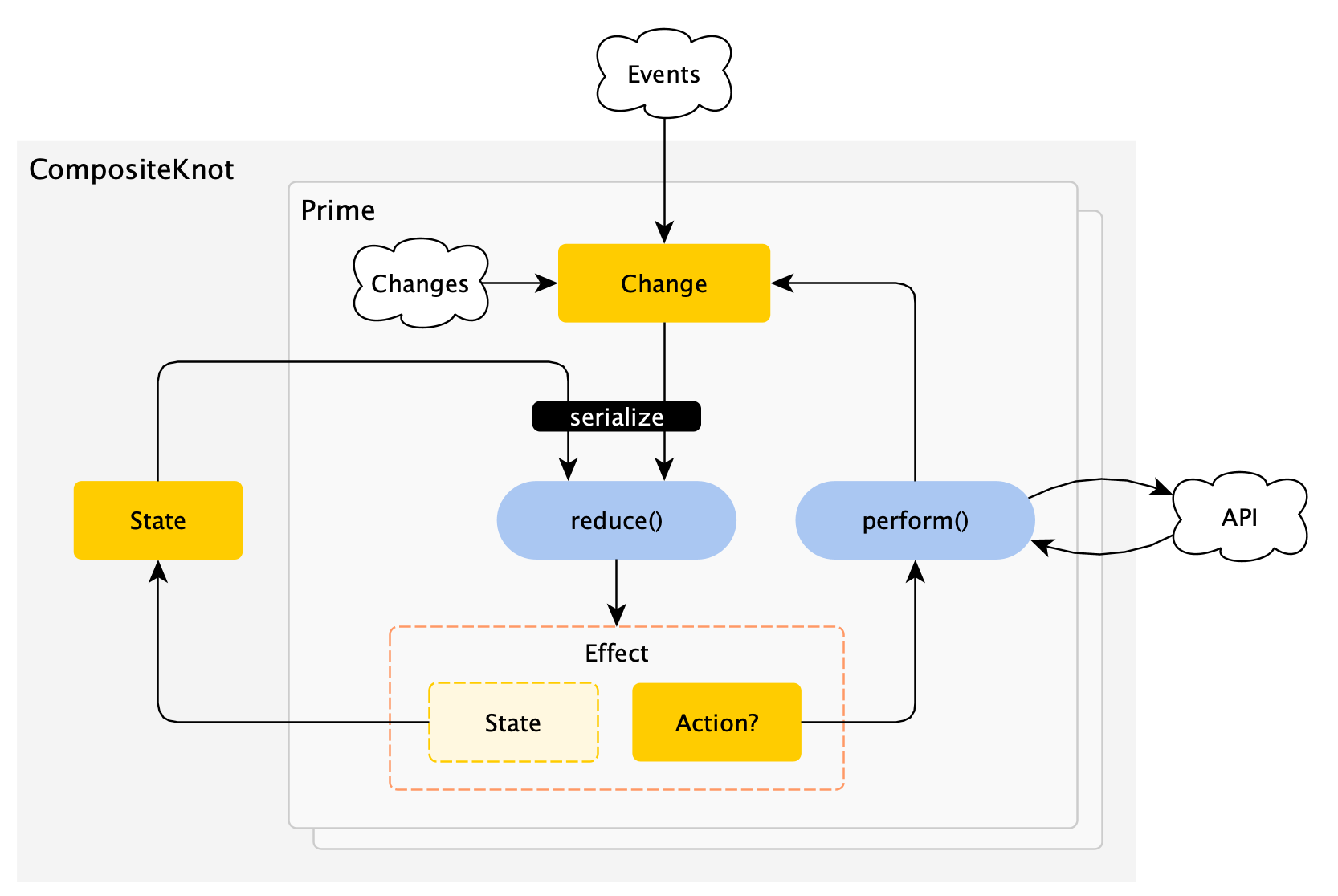beworker / Knot
Programming Languages
Projects that are alternatives of or similar to Knot
🧶 Knot
Concise reactive state container library for Android applications.
Concept
Knot helps managing application state by reacting on events and performing asynchronous actions in a structured way. There are five core concepts Knot defines: State, Change, Action, Reducer and Effect.

State represents an immutable state of an application. It can be a state of a screen or a state of an internal statefull headless component.
Change is an immutable data object with an optional payload intended for changing the State. A Change can be produced from an external source or be a result of execution of an Action.
Action is a synchronous or an asynchronous operation which, when completed, can – but doesn't have to – emit a new Change.
Reducer is a function that takes the previous State and a Change as arguments and returns the new State and an optional Action wrapped by the Effect class. Reducer in Knot is designed to stay side-effects free because each side-effect can be turned into an Action and returned from the reducer function together with a new state in a pure way.
Effect is a convenient wrapper class containing the new State and an optional Action. If Action is present, Knot will perform it and provide resulting Change (if any) back to the Reducer.
In addition to that each Knot can subscribe to Events coming from external sources and turn them into Changes for further processing.
Getting Started
The example below declares a Knot capable of loading data, handling Success and Failure loading results and reloading data automatically when an external "data changed" signal gets received. It also logs all State mutations as well as all processed Changes and Actions in console.
sealed class State {
object Initial : State()
object Loading : State()
data class Content(val data: String) : State()
data class Failed(val error: Throwable) : State()
}
sealed class Change {
object Load : Change() {
data class Success(val data: String) : Change()
data class Failure(val error: Throwable) : Change()
}
}
sealed class Action {
object Load : Action()
}
val knot = knot<State, Change, Action> {
state {
initial = State.Initial
}
changes {
reduce { change ->
when (change) {
is Change.Load -> State.Loading + Action.Load
is Change.Load.Success -> State.Content(data).only
is Change.Load.Failure -> State.Failed(error).only
}
}
}
actions {
perform<Action.Load> {
switchMapSingle<String> {
loadData()
.map<Change> { Change.Load.Success(it) }
.onErrorReturn { Change.Load.Failure(it) }
}
}
}
events {
source {
dataChangeObserver.signal.map { Change.Load }
}
}
}
val states = knot.state.test()
knot.change.accept(Change.Load)
states.assertValues(
State.Initial,
State.Loading,
State.Content("data")
)
Notice how inside the reduce function a new State can be combined with an Action using + operator. If only the State value should be returned from the reducer, the .only suffix is added to the State.
Composition
If your knot becomes complex and you want to improve its readability and maintainability, you may consider to write a composite knot. You start composition by grouping related functionality into, in a certain sense, indecomposable pieces called Delegates.

Each Delegate is isolated from the other Delegates. It defines its own set of Changes, Actions and Reducers. It's only the State, what is shared between the Delegates. In that respect each Delegate can be seen as a separate Knot working on a shared State. Once all Delegates are defined, they can be composed together and provided to CompositeKnot which implements standard Knot interface. For more information check out Composite ViewModel post.
Documentation
- Knot Sample App is the first place to look at.
- Async Actions to learn how to perform and cancel asynchronous actions.
- External Events to learn how to observe and handle external events.
- Terminal events in Actions section
- Composite ViewModel to learn more about composition.
- Troubleshooting
Other examples
Why Knot?
- Predictable - state is the single source of truth.
- Side-effect free reducer - by design.
- Scalable - single knots can be combined together to build more complex application logic.
- Composable - complex knots can be composed out of delegates grouped by related functionality.
- Structured - easy to read and write DSL for writing better structured and less buggy code.
- Concise - it has minimalistic API and compact implementation.
- Testable - reducers and transformers are easy to test.
- Production ready - Knot is used in production.
- Why not?
RxJava3 Binaries 
allprojects {
repositories {
mavenCentral()
}
}
dependencies {
implementation "de.halfbit:knot3:<version>"
// Becase Knot is not released for each and every RxJava version,
// it is recommended you also explicitly depend on RxJava's latest
// version for bug fixes and new features.
implementation 'io.reactivex.rxjava3:rxjava:3.0.4'
}
RxJava2 Binaries 
allprojects {
repositories {
mavenCentral()
}
}
dependencies {
implementation "de.halfbit:knot:<version>"
// Becase Knot is not released for each and every RxJava version,
// it is recommended you also explicitly depend on RxJava's latest
// version for bug fixes and new features.
implementation 'io.reactivex.rxjava2:rxjava:2.2.19'
}
Inspiration
Knot was inspired by two awesome projects
License
Copyright 2019, 2020 Sergej Shafarenka, www.halfbit.de
Licensed under the Apache License, Version 2.0 (the "License");
you may not use this file except in compliance with the License.
You may obtain a copy of the License at
http://www.apache.org/licenses/LICENSE-2.0
Unless required by applicable law or agreed to in writing, software
distributed under the License is distributed on an "AS IS" BASIS,
WITHOUT WARRANTIES OR CONDITIONS OF ANY KIND, either express or implied.
See the License for the specific language governing permissions and
limitations under the License.


